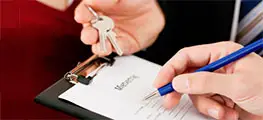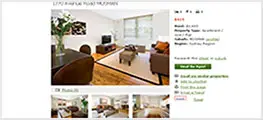Renting a first home
 Unless you’ve managed to buy a house in Australia before you move over here or you are planning to stay with relatives in Australia, it is most likely your first home will be a rented house or apartment. There are pros and cons to this and you have to be aware of the pitfalls of renting as well as the advantages it offers.
Unless you’ve managed to buy a house in Australia before you move over here or you are planning to stay with relatives in Australia, it is most likely your first home will be a rented house or apartment. There are pros and cons to this and you have to be aware of the pitfalls of renting as well as the advantages it offers.
If you are here on a temporary visa, it will be more difficult and more expensive for you to buy than it is for residents or those with permanent visas. This is because you will not be entitled to grants or Stamp Duty exemptions as a first time owner.
If you’re planning to stay just for a year or two, it might not be worth buying a house, because of the taxes and other expenses involved. Additionally, depending on the volatility of the global economy, it might not make sense to invest in property outside your home country.
How to find a rental property
Ssearching for a property may be diffrent from your home country. Nowadays, Austrliasn do most of their searching online, but there are still print advertisments available to consider. There are many things to consider like how many rooms you need, garden space for children, proximity to public transport, parking spaces, and of course, your budget. Know what you want and need before you start the search in order to make the process faster and more targeted.
Choosing a location
You should apply the same criteria to finding a rental property as you would to buying a house. This is especially true if you intend renting for a long time.
Keep in mind, the word suburb means the residential outskirts of a city. However, in Australia, we use SUBURB to describe the different areas within a city. Each council or municipality is called a suburb. For example, you might live in the suburb of Newtown in Sydney, or Hendra in Queensland. The city itself, for example Sydney, is usually the downtown/business district and locals understand it to mean that part of the city of Sydney. Yes…a little confusing when you are searching for a location to live!
First find a suburb that you like, that you can afford, and which is convenient for work. Also, if you are emigrating with a family you need to check out the local schools.
In our opinion, Wikipedia is a great way to research the suburbs in Australia. Simply type in the suburb/state for a generally good to great overview of the area. The bottom of the article usually has additional links to help you with your research.
Australian Suburban Trends shares statistics on education levels, transport, and crime. The data within the search is a bit old, but it gives you the general expection for each suburb. The links in the bottom right go to the sources of the information, so you can also research on those sites for more up-to-date information.
Online property search
 The most useful resource for finding a rental property is the internet. In the Google Search bar, enter ‘Property to Rent’ followed by the name of the city or town you are planning to move for a wealth of options.
The most useful resource for finding a rental property is the internet. In the Google Search bar, enter ‘Property to Rent’ followed by the name of the city or town you are planning to move for a wealth of options.
The great thing about searching for a porerty on the internet is the amount of deatial you can learn. Unlike a newspaper ad that only has a few lines of information, you can expect a map of the location, external and internal photos, and a detailed description of the property’s features. A couple of very helpful sites are:
These sites are quite user-friendly. Just enter the suburb, size of house and your price range for the weekly rent. They then bring up a selection of properties, usually ordered according to rental price.
Newspapers & local media
Local newspapers usually carry a rental property section on a specific weekday and a supplement at the weekend. Also, free local weekly newspapers have similar property listings. Advertisements in the newspapers usually provide information on a guide weekly rental price and location.
Real estate agents (realtors)
Agents can be found on almost every main street in the suburb you are interested in. They do not only buy and sell houses. Most estate agents (especially the larger, national companies) have rental property departments, and they advertise rental properties in their display wondows. The rental departments are normally referred to as letting agents.
As well as Main Street real estate agents, there are also companies who specialise in only in rental property (Letting Agents). They keep printed lists of rental properties organised according to weekly price.
Unfortunately, you cannot expect a rental agent to help you find a place. They are very good at showing you specific properties once you’ve expressed interest, but they will not organise visits or escort you to multiple properties as happens in many countries. Be prepared to deal with several different agents as you search for a rental property.
‘For rent’ or ‘for lease’ signs
Properties that are placed on the rental market are often advertised using display boards outside the property. These carry details of the property and contact information for the letting agent.
Renting
There is a huge demand for rental property in Australia and so rents are generally high. This is thanks to a number of factors:
- Shortage of properties for the growing population
- House prices are high pushing up rental prices
- Many foreign workers are entering the country to take up jobs, especially in the resources sector. This adds to the pressure on the number of rentals available especially in areas where the boom is greatest.
A sign of how huge the demand is comes from the fact that in Sydney, there is only a 1% rental vacancy rate, and quite often rental agents have twenty applicants for every rental property put on the market.
Because of this great demand, rental prices are high. A small apartment in the less desirable suburbs of the larger Australian cities will cost at least $200 per week. At the top end, the sky is the limit. In the most up-market districts, five-bedroom, three-bathroom homes with views and pools can rent for up to $15,000 a week. Obviously, rural rental property, or rentals in smaller towns, are cheaper than in the capital cities.
Average rents in major capitals
|
Ranking |
City |
Median weekly rental |
|
|
||
|
1 |
Darwin |
$553 |
|
2 |
Sydney |
$511 |
|
3 |
Canberra |
$479 |
|
4 |
Melbourne |
$403 |
|
5 |
Brisbane |
$392 |
|
6 |
Perth |
$390 |
|
7 |
Adelaide |
$340 |
|
8 |
Hobart |
$316 |
An extremely useful site for finding the average price of every suburb in Australia can be found at: Average Rent Australia.
It would also be worth visiting: Realestateview.com.au
Another useful site is Realestate.com.au
Rules and regulations
- Renting is a heavily regulated process in Australia. Some things to remember:
- You will have to pay a month’s rent in advance
- You will have to pay a bond (usually 4 weeks rent). The bond is lodged with a State government body called the Rental Tenancies Authority (RTA) and kept in an independent holding account. The account pays interest to the tenant when he bond is released.
- To succeed in applying for a rental property you will have to:
|
- Some landlords object to pets while others are relaxed about it. Officially, if you wish to keep pets in a rental and the landlord agrees to it, you will have to pay an extra two weeks of bond.
Consider insurance
While the property belongs to the landlord, you should consider getting insurance to protect your possessions such as furniture and personal items, from theft or damage. You can normally cover this through what’s known as Contents Insurance. This can be arranged through our financial partner ANZ. Find out more here.
Inspections
Every tenant in Australia goes through numerous inspections of the property they are renting. These are usually done by the agent, but the owner may also attend.
Pre-inspection
 You will be shown an in-going report by the rental agent. This will specify the precise condition of the property at the time you take up tenancy. The letting agent may also take photographs of the condition of the property. You may also take your own photos to document the state of the property especially if something is in need of repair.
You will be shown an in-going report by the rental agent. This will specify the precise condition of the property at the time you take up tenancy. The letting agent may also take photographs of the condition of the property. You may also take your own photos to document the state of the property especially if something is in need of repair.
You will need to thoroughly check the in-going property report and raise any concerns before signing it. It is important to do this because this report will be the basis upon which the agent and landlord will judge how well you have treated the property during the tenancy and therefore influence the return of your bond.
On-going inspections
Australian rental properties are normally inspected by the rental agent every three to six months of occupancy. You will be expected to be available to the agent at the time of the inspection. The property should be in pristine condition as any problems found with the property will be reported to the landlord and could affect your continued tenancy. Any damage identified during the inspection will be noted and you will be expected to repair it at your own expense.
You should report any problems you’re having with the property at this time or discuss any concerns you have with the agent. Failure to do so could affect the return of your bond.
Final inspection
At the end of your tenancy, the rental agent will conduct another inspection and compare it to the pre-inspection report prepared before you move in. Any damage or degradation to the property beyond normal wear and tear will be deducted from the bond you lodged to secure the tenancy.
The Rental Tenancies Authority (RTA) has a very detailed website which can tell you anything you wish to know about renting in Australia
The pros and cons of renting
The pros:
- The landlord is responsible for maintaining the condition of your rented home and for repairing anything that goes wrong promptly.
- You do not have to find a large deposit to buy a house.
- You do not need to pay a mortgage.
The cons:
- You are responsible for any damage caused to the property except for ‘fair wear and tear’ or through anything that is not your doing – damage caused by bad weather or damage caused by contractors employed by the agent or landlord.
- You have to pay a 4-week bond and 4-weeks rent in advance.
- All the money you pay goes to the agent and the landlord. You are not paying off a mortgage.
- It is not your home.
Vacating the rental property (moving out)
In Australia, there are strict laws protecting both landlords and tenants. The letting agent, who charges the owner of the property a percentage of the rent, is meant to act as middleman between yourself and your landlord. They are there to help both parties if there are any disputes or if any serious problems arise.
At the end of your tenancy, you’ll be given an out-going report detailing the condition of the premises. You must go through this with the agent checking everything is in order. If you agree with the contents of this report, you must sign it. The owner and the agent will then compare the in-going and out-going condition reports and decide if you are entitled to your bond in full.
This is often a matter of contention between the tenant and the landlord. A good agent will smooth things over and help reach an amicable agreement about any differences of opinion. If this fails, the tenant may take up the matter with the Consumer, Trader and Tenancy Tribunal (CTTT). This is a government agency that is there to resolve disputes between landlords and tenants.
For more information on the rights of the tenant and the landlord, visit: Applications
This particular site is for the CTTT in New South Wales, but each state has a very similar authority.







